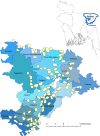Food and Agricultural Approaches to Reducing Malnutrition (FAARM): protocol for a cluster-randomised controlled trial to evaluate the impact of a Homestead Food Production programme on undernutrition in rural Bangladesh
- PMID: 31278109
- PMCID: PMC6615849
- DOI: 10.1136/bmjopen-2019-031037
Food and Agricultural Approaches to Reducing Malnutrition (FAARM): protocol for a cluster-randomised controlled trial to evaluate the impact of a Homestead Food Production programme on undernutrition in rural Bangladesh
Abstract
Introduction: Chronic undernutrition affects over 150 million children worldwide and has serious consequences. The causes are complex and include insufficient dietary diversity and poor hygiene practices. Systematic reviews of nutrition-sensitive agricultural interventions concluded that while these hold promise, there is insufficient evidence for their impact on child growth. The Food and Agricultural Approaches to Reducing Malnutrition (FAARM) project is a 1:1 cluster-randomised trial aiming to evaluate the impact of a Homestead Food Production (HFP) programme implemented by Helen Keller International on women's and children's undernutrition.
Methods and analysis: The HFP intervention comprises training of women's groups and asset distribution to support year-round home gardening, poultry rearing and improved nutrition and hygiene practices. Formal trainings are supplemented by behaviour change communication during household visits, and facilitated links between producer groups and market actors. The FAARM trial will examine if and how this complex intervention reduces undernutrition. In 2015, FAARM enrolled married women and their children (0-3 years) in 96 rural settlements of Habiganj district in Sylhet division, Bangladesh. Covariate-constrained randomisation was used to assign 48 settlements to receive a 3-year HFP intervention, with the other 48 acting as controls, targeting over 2700 women. To study impact pathways, a surveillance system collects data on all participants every 2 months. In late 2019, children 0-3 years of age (born during the intervention period) will be surveyed, thus capturing impact during the critical first 1000 days of life. Children's length/height-for-age z-scores will be compared between intervention and control arms using mixed-effects linear regression. Secondary outcomes include women's and children's micronutrient status, dietary intake, dietary diversity and other indicators of child growth, development and morbidity.
Ethics and dissemination: Ethical approval was received in Bangladesh and Germany. Results will be disseminated through peer-reviewed publications and presentations in Bangladesh and internationally.
Trial registration number: NCT02505711; Pre-results.
Keywords: community child health; epidemiology; nutrition; public health.
© Author(s) (or their employer(s)) 2019. Re-use permitted under CC BY. Published by BMJ.
Conflict of interest statement
Competing interests: None declared.
Figures




References
-
- Ruel M, Hoddinott J. Investing in early childhood nutrition. IFPRI Policy Briefs. Washington DC: International Food Policy Research Institute, 2008.
-
- UNICEF. Strategy for improved nutrition of children and women in development countries. New York, USA: UNICEF, 1990.
Publication types
MeSH terms
Associated data
LinkOut - more resources
Full Text Sources
Medical
